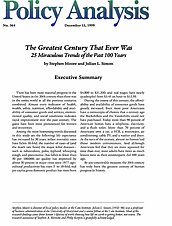Among the most heartening trends discussed in this study are the following: life expectancy has increased by 30 years; infant mortality rates have fallen 10-fold; the number of cases of (and the death rate from) the major killer diseases–such as tuberculosis, polio, typhoid, whooping cough, and pneumonia–has fallen to fewer than 50 per 100,000; air quality has improved by about 30 percent in major cities since 1977; agricultural productivity has risen 5- to 10-fold; real per capita gross domestic product has risen from $4,800 to $31,500; and real wages have nearly quadrupled from $3.45 an hour to $12.50.
During the course of this century, the affordability and availability of consumer goods have greatly increased. Even most poor Americans have a cornucopia of choices that a century ago the Rockefellers and the Vanderbilts could not have purchased. Today more than 98 percent of American homes have a telephone, electricity, and a flush toilet. More than 70 percent of Americans own a car, a VCR, a microwave, air conditioning, cable TV, and a washer and dryer. At the turn of the century, almost no homes had those modern conveniences. And although Americans feel that they are more squeezed for time than ever, most adults have twice as much leisure time as their counterparts did 100 years ago.
By any conceivable measure, the 20th century has truly been the greatest century of human progress in history.

